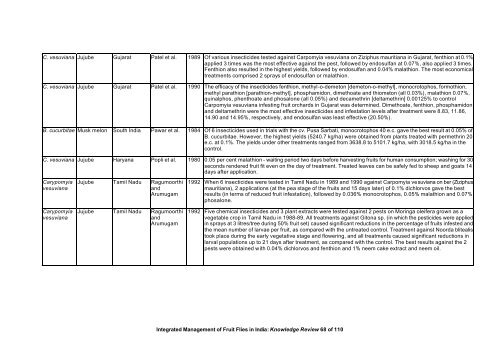“Key Informant Survey” of Production, Value, Losses and ... - DfID
“Key Informant Survey” of Production, Value, Losses and ... - DfID
“Key Informant Survey” of Production, Value, Losses and ... - DfID
Create successful ePaper yourself
Turn your PDF publications into a flip-book with our unique Google optimized e-Paper software.
C. vesuviana Jujube Gujarat Patel et al. 1989 Of various insecticides tested against Carpomyia vesuviana on Ziziphus mauritiana in Gujarat, fenthion at 0.1%<br />
applied 3 times was the most effective against the pest, followed by endosulfan at 0.07%, also applied 3 times.<br />
Fenthion also resulted in the highest yields, followed by endosulfan <strong>and</strong> 0.04% malathion. The most economical<br />
treatments comprised 2 sprays <strong>of</strong> endosulfan or malathion.<br />
C. vesuviana Jujube Gujarat Patel et al. 1990 The efficacy <strong>of</strong> the insecticides fenthion, methyl-o-demeton [demeton-o-methyl], monocrotophos, formothion,<br />
methyl parathion [parathion-methyl], phosphamidon, dimethoate <strong>and</strong> thiometon (all 0.03%), malathion 0.07%,<br />
quinalphos, phenthoate <strong>and</strong> phosalone (all 0.05%) <strong>and</strong> decamethrin [deltamethrin] 0.00125% to control<br />
Carpomyia vesuviana infesting fruit orchards in Gujarat was determined. Dimethoate, fenthion, phosphamidon<br />
<strong>and</strong> deltamethrin were the most effective insecticides <strong>and</strong> infestation levels after treatment were 8.83, 11.86,<br />
14.90 <strong>and</strong> 14.95%, respectively, <strong>and</strong> endosulfan was least effective (20.50%).<br />
B. cucurbitae Musk melon South India Pawar et al. 1984 Of 6 insecticides used in trials with the cv. Pusa Sarbati, monocrotophos 40 e.c. gave the best result at 0.05% <strong>of</strong><br />
B. cucurbitae. However, the highest yields (5240.7 kg/ha) were obtained from plants treated with permethrin 20<br />
e.c. at 0.1%. The yields under other treatments ranged from 3638.8 to 5101.7 kg/ha, with 3018.5 kg/ha in the<br />
control.<br />
C. vesuviana Jujube Haryana Popli et al. 1980 0.05 per cent malathion - waiting period two days before harvesting fruits for human consumption; washing for 30<br />
seconds rendered fruit fit even on the day <strong>of</strong> treatment. Treated leaves can be safely fed to sheep <strong>and</strong> goats 14<br />
days after application.<br />
Carypomyia<br />
vesuviana<br />
Carypomyia<br />
vesuviana<br />
Jujube Tamil Nadu Ragumoorthi<br />
<strong>and</strong><br />
Arumugam<br />
Jujube Tamil Nadu Ragumoorthi<br />
<strong>and</strong><br />
Arumugam<br />
1992 When 6 insecticides were tested in Tamil Nadu in 1989 <strong>and</strong> 1990 against Carpomyia vesuviana on ber (Ziziphus<br />
mauritiana), 2 applications (at the pea stage <strong>of</strong> the fruits <strong>and</strong> 15 days later) <strong>of</strong> 0.1% dichlorvos gave the best<br />
results (in terms <strong>of</strong> reduced fruit infestation), followed by 0.036% monocrotophos, 0.05% malathion <strong>and</strong> 0.07%<br />
phosalone.<br />
1992 Five chemical insecticides <strong>and</strong> 3 plant extracts were tested against 2 pests on Moringa oleifera grown as a<br />
vegetable crop in Tamil Nadu in 1988-89. All treatments against Gitona sp. (in which the pesticides were applied<br />
in sprays at 3 litres/tree during 50% fruit set) caused significant reductions in the percentage <strong>of</strong> fruits infested <strong>and</strong><br />
the mean number <strong>of</strong> larvae per fruit, as compared with the untreated control. Treatment against Noorda blitealis<br />
took place during the early vegetative stage <strong>and</strong> flowering, <strong>and</strong> all treatments caused significant reductions in<br />
larval populations up to 21 days after treatment, as compared with the control. The best results against the 2<br />
pests were obtained with 0.04% dichlorvos <strong>and</strong> fenthion <strong>and</strong> 1% neem cake extract <strong>and</strong> neem oil.<br />
Integrated Management <strong>of</strong> Fruit Flies in India: Knowledge Review 68 <strong>of</strong> 110

















